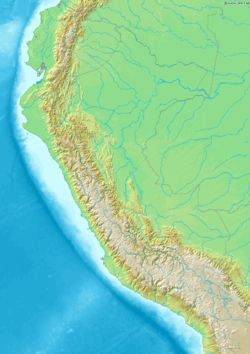- Chankillo
-
Chankillo
Chanquillo
Remains of the hilltop fortress Chankillo Location Location of Chanquillo in PeruCoordinates 9°33′24″S 78°14′09″W / 9.55667°S 78.23583°WCoordinates: 9°33′24″S 78°14′09″W / 9.55667°S 78.23583°W Period 300 BC Country  Peru
PeruRegion Ancash Elevation 300 m (980 ft) Area 4 km2 (1.5 sq mi) Chankillo is an ancient monumental complex in the Peruvian coastal desert, found in the Casma-Sechin Oasis in the Ancash Department of Peru. The ruins include the hilltop Chankillo fort, the nearby Thirteen Towers solar observatory, and residential and gathering areas. The Thirteen Towers are believed to have been a solar observatory built in the 4th century BC.[1][2] As of 2008, the culture that produced Chankillo is unnamed.[3]
The site covers about four square kilometres (1.5 square miles) and is believed to be a fortified temple that was occupied in the 4th Century BC.[4]
Contents
The Thirteen Towers solar observatory
The Thirteen Towers of Chankillo run north to south along a ridge of a low hill and are regularly spaced, forming a "toothed" horizon with narrow gaps at regular intervals. To the east and west investigators found two observation points. From these vantages, the 300m long spread of the towers along the horizon corresponds very closely to the rising and setting positions of the Sun over the year.[1][2] This suggests that some activities of the ancient civilization were regulated by a solar calendar.
The towers had been known to travelers for centuries, but the astronomical function of the towers was discovered in 2007 by Iván Ghezzi and Clive Ruggle.[5]
See also
- List of archaeoastronomical sites by country
Notes
- ^ a b Ghezzi and Ruggles (2007).
- ^ a b BBC/Open University documentary, Broadcast March 2011, Downloadable demonstration of Towers at sunrise.
- ^ Atwood
- ^ Ghezzi (2006)
- ^ Atwood, Roger. " "Solar Observatory at Chankillo, Peru." Archaeology. Volume 61 Number 1, January/February 2008. http://www.archaeology.org/0801/topten/solar_observatory.html.
References
-
- Ghezzi, Ivan (2006). "Religious Warfare at Chankillo". In William Harris Isbell and Helaine Silverman (eds.). Andean Archaeology III: North and South. New York: Springer. pp. 67–84. doi:10.1007/0-387-28940-2. ISBN 978-0-387-28939-7. OCLC 71272735.
- Ghezzi, Ivan; and Clive Ruggles (2 March 2007). "Chankillo: A 2300-Year-Old Solar Observatory in Coastal Peru". Science (Washington, DC: AAAS) 315 (5816): pp. 1239–1243. doi:10.1126/science.1136415. ISSN 0036-8075. OCLC 110607624. PMID 17332405.
External links
- Towers point to ancient Sun cult, BBC
- Giant Solar Calendar Measures Time, BBC
- Early Monumental Architecture on the Peruvian Coast
- Yale University article: Peruvian Citadel is Site of Earliest Ancient Solar Observatory in the Americas and slide show
- View from the air on the Chankillo site
- Wonders of the Universe, Prof. Brian Cox, BBC (maybe region locked to UK only)
Archaeological sites in Peru  Acaray | Aspero | Bandurria | Buena Vista | Cahuachi | Cajamarquilla | Carajía | Caral | Cerro Pátapo | Chan Chan | Chankillo | Chavín de Huantar | Choquequirao | Coricancha | Cota Coca | Cumbe Mayo | Cusichaca valley | El Brujo | Garagay | Gran Pajáten | Gran Vilaya | Guitarrero Cave | Huaca de la Luna | Huaca del Sol | Huaca Pucllana | Huayna Picchu | Huilcahuain | Incahuasi, Ayacucho | Incahuasi, Cañete | Intihuatana | Jiskairumoko | Kenko | Kuelap | Kuntur Wasi | Llactapata | Machu Picchu | Miculla petroglyphs | Muyucmarca | Ollantaytambo | Pachacamac | Pikillacta | Pikimachay | Piruro | Písac | Puca Pucara | Pumacocha | Puyupatamarca | Qoriwayrachina | Raqchi | Rumicolca | Sacred Valley | Sacsayhuamán | Sayhuite | Sechin, Peru | Sillustani | Sipán | Tambo Colorado | Tambomachay | Tarahuasi | Tipón | Toquepala Caves | Toro Muerto | Túcume | Uchkus–Inkañan | Vilcabamba | Vitcos | Wari ruins | Wiñay Wayna | YanacaCategories:
Acaray | Aspero | Bandurria | Buena Vista | Cahuachi | Cajamarquilla | Carajía | Caral | Cerro Pátapo | Chan Chan | Chankillo | Chavín de Huantar | Choquequirao | Coricancha | Cota Coca | Cumbe Mayo | Cusichaca valley | El Brujo | Garagay | Gran Pajáten | Gran Vilaya | Guitarrero Cave | Huaca de la Luna | Huaca del Sol | Huaca Pucllana | Huayna Picchu | Huilcahuain | Incahuasi, Ayacucho | Incahuasi, Cañete | Intihuatana | Jiskairumoko | Kenko | Kuelap | Kuntur Wasi | Llactapata | Machu Picchu | Miculla petroglyphs | Muyucmarca | Ollantaytambo | Pachacamac | Pikillacta | Pikimachay | Piruro | Písac | Puca Pucara | Pumacocha | Puyupatamarca | Qoriwayrachina | Raqchi | Rumicolca | Sacred Valley | Sacsayhuamán | Sayhuite | Sechin, Peru | Sillustani | Sipán | Tambo Colorado | Tambomachay | Tarahuasi | Tipón | Toquepala Caves | Toro Muerto | Túcume | Uchkus–Inkañan | Vilcabamba | Vitcos | Wari ruins | Wiñay Wayna | YanacaCategories:- Archaeological sites in Peru
- Astronomical observatories in Peru
- Forts in Peru
- History of Peru
- Archaeoastronomy
- Former populated places in Peru
Wikimedia Foundation. 2010.

